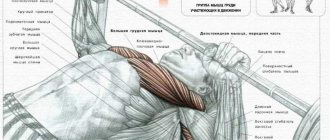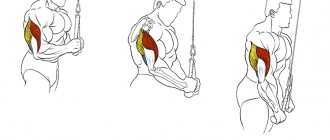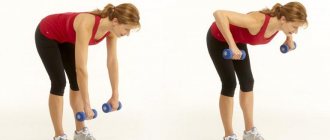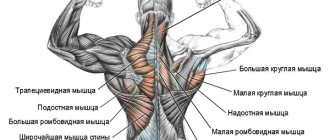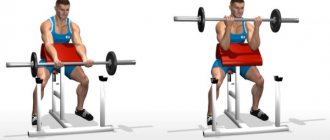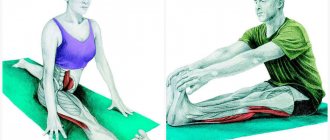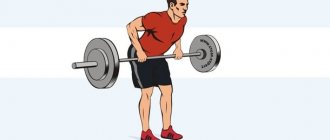( 2 ratings, average: 5.00 out of 5)
Home » Exercises
One of the most effective exercises for bodybuilders is the barbell row while lying face down on a bench. The method gives results that will impress even athletes with extensive experience. This craving is difficult to replace, although it is possible. It is important to know how to perform this exercise correctly so that it brings only benefits.
Features of the exercise
The dumbbell exercise has a lot in common with the bent-over barbell row. It also belongs to the category of basic, since several muscle groups, the shoulder and elbow joints are involved in its execution. During exercise, the latissimus, trapezius muscles, rear deltoids and biceps are tensed. The correct stance and execution technique ensure an emphasis on working out and stretching the back muscles. To do this, the effort is made by bringing the shoulder blades together, the elbow joint moves vertically, up and down without deviation from the axis of the spine. Inhale when lowering, exhale when the projectile is at the top point.
Modifications of the starting position allow you to vary the difficulty and select more gentle options using support. When doing bent-over rows while standing on both legs, they work with fairly large weights, obtaining a balanced development of the right and left areas of the back, static load of the abs and hamstrings. Changing the angle between the body and the shoulder joint transfers force from the deltoids to the muscles of the lumbar triangle. When the elbows are abducted, the deltoids are loaded; when positioned closer to the body, the rest of the back is loaded. The trajectory of movements is combined, achieving a balanced study of all zones.
Benefits and possible contraindications
The exercise is easier to perform than with a barbell, especially with the use of support, when part of the weight is compensated. However, it requires competent technique, knowledge of which muscles work in order to achieve the planned result. Benefits of training with dumbbells:
- The ability to rotate the hand when lifting, change the grip from straight to neutral. As a result, more muscles are involved and mass is gained more effectively.
- The hand with the apparatus rises higher than during an exercise with a barbell. Since the dumbbells are not connected by a bar that interferes with lifting, the amplitude of movement of the projectile and muscle contraction is significantly greater.
- When exercising with dumbbells, they work with lighter weights, but it is possible to choose a variation of the exercise that will relieve the load on the lower back and legs.
Bent over dumbbell rows have their contraindications. Increased axial load can lead to complications of spinal problems: hernia, protrusion, hyperkyphosis, hyperlordosis, especially exercises with one hand. With poor stretching, it is impossible to maintain the desired position, which implies arching of the lower back and abduction of the pelvis. Beginners or athletes returning to physical condition do not need to use heavy dumbbells. There is a danger of excessive stress on the back, shoulder and elbow ligaments, and possible pinching in the cervical or thoracic spine.
When performing an exercise with dumbbells, it is possible to raise your arms higher than when using a barbell.
The weight of the dumbbell is selected depending on the level of training
You can choose a variation of the exercise that will relieve the load on the lower back and legs.
What muscles work
Performing deadlifts is aimed at strengthening:
- Latissimus dorsi muscle.
- Trapezius muscles.
- Upper back muscles.
However, the deltoid muscles are also involved in the process. It turns out that this is one of the most effective exercises with a barbell for the back.
Knowing which muscles work, it is possible to use the method in a timely and systematic manner to avoid a situation where, with the remaining muscle groups developed, the dorsal part of them remains weak.
Of course, to some extent, many other muscles become toned during deadlifting. However, this is a minor load, which is unlikely to play any role for a person in good shape.
As for the target muscle groups, they will be well loaded and worked out. The end result will be impressive. The main thing is not to overdo it and give your body timely rest.
Varieties and technique of execution
Rows of two dumbbells or exercises using one apparatus - both modifications allow you to pump up your back, mainly the latissimus muscle. When doing bent-over dumbbell rows with one arm, it will take twice as long to achieve the same load as when exercising with a barbell or two dumbbells. Athletes also use different body position options when performing, which makes it possible to partially transfer the load from one area to another, leaning on a bench or lying down.
One hand
One-arm dumbbell rows are performed with support:
- Athletes stand on the bench with their knee, lean forward, and lean on their forearm.
- The body is placed parallel to the surface of the support, the hip joint is bent at a right angle. The deflection in the lower back with a straight back fixes the correct position of the spinal column.
- The second leg is bent at the knee, placed on the floor, slightly pulled back. Head straight, gaze ahead, neck motionless.
- The projectile is held with a full grip, at the lowest point the elbow is left slightly bent. When lifting a dumbbell to the belt with one hand, the elbow joint is directed straight up, without moving to the side. With the correct trajectory, the dumbbell is pulled to the stomach, and not to the chest.
- The projectile is fixed for 1–2 seconds, then smoothly lowered down.
To make it more difficult, both legs are placed on the floor, the body is placed parallel to the floor, and only the hand rests on the bench. This version also removes part of the load from the lumbar region, making it possible to train in a gentle mode or use a heavier weight apparatus.
On an incline bench
Dumbbell rows on an incline bench unload the back extensors, remove excess stress from the lower back, and are suitable for athletes who have back problems. The height is selected arbitrarily, the angle of inclination of the projectile is changed from horizontal to 30–45 degrees, but the hands with dumbbells should always not touch the floor at the lowest point. Lying on a bench, athletes do not turn their necks, their chin is above the edge of the support, and their gaze is directed in front of them. The legs are placed and supported so that the position is stable and comfortable. The techniques for correctly performing dumbbell rows while lying on your stomach are similar to the standing technique. The latissimus muscle works, in the upper phase the hands are raised to the support, the shoulder blades are brought together, held for 1-2 seconds and the arms are smoothly lowered.
Performing rows while lying on an incline bench will become more difficult if you lower the apparatus to a position parallel to the floor.
Raising two dumbbells to the waist
Standing dumbbell rows are performed without support:
- The legs are placed on the entire foot, slightly bent.
- The body is tilted forward 45–90 degrees. With increasing inclination, there is more emphasis on the work of the latissimus muscle, but the load on the lumbar region is higher.
- The head is kept straight, the back is straight, the pelvis is pulled back. They pull the projectile using the force of the back muscles, using their hands minimally.
- The dumbbells are pulled straight up and down, without bending forward or backward.
- In the upper phase of the amplitude, the shoulder blades are brought together as much as possible.
- When moving your arms, your hands are turned 90 degrees, your elbows are not spread out to the sides, and your arms are not raised too high.
- They return to the starting position smoothly.
When the dumbbells are lowered, the arms are almost straightened, but not completely relaxed. Beginners should take into account one nuance - in order to maintain a curve in the lumbar region, you need a good stretch. The weight of the dumbbells is increased carefully so as not to overload the spine.
Nuances
It is important not to lift your chest off the bench. Otherwise, emphasis is lost, and the load on other parts of the body increases. This leads to injury and makes the technique less effective.
It is also important to understand that the load on the chest should not be extreme. Otherwise, injury may also occur. In order not to overload the chest, it is better to avoid the maximum weight.
To perform the exercise correctly, it is important to keep your elbows close to your body. In this situation, the shoulder muscles work less. If it is difficult to hold sports equipment in your hands, you can use straps. If in this case the technique is difficult, it is better to stop the exercise and do something easier. Then, when the body is ready, it is possible to return to the method.
There are variations of the technique. There are two of them. In one case, the same thing is done, but the bench is located horizontally to the floor. In such a situation, there is a chance to better work the rhomboid muscles on the back. However, to do this you will have to squeeze your shoulder blades together.
However, this option will not be feasible for everyone. Unlike incline rows, the load shifts upward because the body position is horizontal. The back muscles work poorly, because the amplitude is shortened.
Another option is a reverse grip. The difference with the classic method is that the biceps play a big role. The amplitude is greater. It is more convenient to lift the barbell from the floor. There is no fundamental difference. If during such an exercise your hands suddenly become sore, this is an alarming sign, and you should consult a doctor and stop training for a while.
If the instructor says that in all respects a person is ready for such a deadlift, but there is pain, discomfort, or simply cannot be performed, this is a reason to worry. Perhaps the fact is that some kind of injury occurred that went unnoticed. It's worth seeing a doctor.
What can be replaced
This method is a basic method, so it can easily be replaced with other exercises. However, if your health and fitness permit, you should not bypass the lying row, because the technique has proven itself to be excellent.
If for some reason this is not suitable, here is what to replace this craving with:
- Bent-over barbell row.
- Push-ups on parallel bars with the body tilted forward. The grip is wide.
- Pull a dumbbell to the stomach with one hand, resting with the other. The person stands at an angle.
- For the latissimus dorsi muscle - traction of vertical and horizontal blocks.
Like bench rows, these exercises require the person to already be fairly prepared. If you had to do office work for twenty years and had no energy left for gymnastics, you can’t start with these kinds of methods.
To begin with, it is worth tidying up the muscles of the whole body, strengthening them and making sure that the cardiovascular system is strong enough and healthy.
If a person suffered an illness, even many years ago, it is better to take this circumstance into account. Some diseases, in principle, are not conducive to heavy physical activity.
That is why in such a situation it is better to consult a doctor first. Then there will be no complications from this or any other technique associated with efforts that are not typical for a person in everyday life.
Increased efficiency
There is no need to rush to include bent-over rows in your training complex, start with high weights and a large number of approaches. At the first stage, you should try different types of exercises and choose the speed of execution. They start with light dumbbells to master the technique and feel the working muscle groups:
- At the top point, pause for 1–2 seconds and fix the position of the arm for peak muscle contraction. The elbow is not moved to the side or forward; the movement of the joint should occur close to the body, so the desired muscle group is loaded.
- If the weight of the dumbbells is heavy or a lot of repetitions are being done, use straps to attach the dumbbells to the wrist. The devices relieve excessive grip tension.
- Bent-over dumbbell rows with one hand are repeated an equal number of times for the right and left halves of the back muscles. The body is held motionless, without moving the lower back to the side. If it is not possible to maintain the starting position unchanged, then reduce the weight of the projectile.
It is important to follow the correct techniques at moments when the projectile is at the extreme points of the amplitude. The dumbbell is not thrown down, tension is maintained in the back muscles, and the elbow joint is slightly bent. The lowered hand is placed perpendicular to the floor, not pressed to the legs.
The movement of the joint should occur close to the body
Common Mistakes
Inaccuracies in technique lead to a decrease in the effectiveness of training. In addition, some inconsistencies during execution are dangerous for the joints or spine. It is necessary to reduce the weight of the dumbbells and change the modification of the exercise if the following signs are noted when performing deadlifts:
- there is not enough strength for a full lift, the hand with the projectile moves only half the amplitude;
- the beginning of the pull is performed with a jerk, the biceps muscles working at the moment of start indicate a shift of the load from the desired muscle zones;
- “round”, the back is hunched, which means there is not enough stretching - it is worth considering the option of an incline bench;
- the head is tilted forward, which violates the anatomical position of the spine and creates a risk of pinching;
- The dumbbells are pulled to the chest, not to the stomach.
If the technique is followed, then after training the athlete feels fatigue in the muscles between and under the shoulder blades. During training, the athlete concentrates on the correct distribution of muscle work; the biceps and arm flexors should be minimally loaded. Only in this way will dumbbell rows give the desired result and become a key exercise for strengthening the back.
Beginners and experienced athletes regularly perform bent-over dumbbell rows. The classic base is modified for different levels of training, performed with small and large weights. This is a great way to get a balanced, developed back, work the latissimus muscles and improve your posture.
Execution technique
Initial position:
- Adjust the bench to an angle of 30 to 45 degrees.
- Lie with your stomach and chest on the back of the bench. Place your feet on the floor.
- Take dumbbells in your hands and hold them on outstretched arms with your palms facing you, spreading your shoulder blades.
Movement:
- As you exhale, pull your arms with the apparatus to the lower part of your chest, bringing your shoulder blades as close as possible to your back.
- After a second pause at the top point of the amplitude, slowly lower your arms to the starting position.
- Repeat as many times as necessary.
Attention!
Recommendations!
Execution options.
What to replace it with?
| One-arm dumbbell row with emphasis on a bench |

